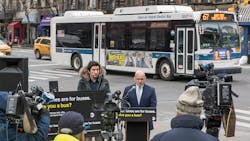MTA bus-mounted camera program begins issuing bus lane violations on B44 SBS route
Motorists caught by the Metropolitan Transportation Authority’s (MTA) new bus-mounted cameras on the B44 Select Bus Service (SBS) route will begin to receive violations with fines up to $250.
The forward-facing cameras on buses serving the B44 SBS route in Brooklyn were implemented Oct. 30, which was the start of a 60-day warning period during which violators were not yet fined for standing or parking in the bus lanes. Since bus-mounted camera enforcement on the B44 began, MTA says data shows an overall improvement in bus speeds of four percent and up to 17 percent on segments of Nostrand and Rogers avenues. The primary indicator of bus reliability, Wait Assessment, is at 78.1 percent on the route – more than three percent higher than the previous year.
“Bus lanes have proven to improve bus speeds and traffic flow for everyone, and proper enforcement is helping to retain those gains and further improve service,” said Craig Cipriano, acting MTA Bus Company president and senior vice president for buses of NYC Transit. “Our message is loud and clear: Bus lanes are for buses.”
MTA says enforced bus lanes are key to improving bus service, and to heighten awareness of their use, New York City Transit (NYC Transit) launched an awareness campaign earlier this month targeted to motorists. It features “Are you a bus?” posters noting that “Bus lanes are for buses,” which have been posted on the backs of the buses equipped with camera systems. The awareness campaign will continue throughout next year as NYC Transit expands the bus-mounted camera program to more bus routes that use New York City Department of Transportation (NYC DOT)-implemented bus lanes throughout the city. NYC Transit is working with NYC DOT to implement transit priority across the city, including the recently announced city commitment to 50 miles of protected bus lanes annually for the next five years.
Bus lanes and their enforcement have proven to improve bus speeds in highly congested areas, helping to increase bus speeds by as much as 36 percent in segments on First and Second Avenues, 17 percent on 96th Street, 16 percent on a portion of Avenue J in Brooklyn and as much as 40 percent near the Manhattan approach of the Hugh L. Carey Tunnel.
“The cameras now mounted on buses along the B44 SBS will help us achieve [New York City] Mayor [Bill] de Blasio’s Better Buses Action Plan to increase citywide bus speeds by 25 percent,” said NYC DOT Commissioner Polly Trottenberg. “We thank NYCT President Andy Byford and the state elected officials who pushed for this additional enforcement. Combined with DOT’s overhead cameras, NYCT’s ABLE camera system is making bus rides faster and more reliable. More automated enforcement on the B44 will help keep riders on Brooklyn’s second-busiest bus route moving between Williamsburg and Sheepshead Bay.”
NYC Transit is currently using the Automated Bus Lane Enforcement (ABLE) system on buses serving the B44 SBS, M14 SBS and M15 SBS routes. The B44 SBS travels on approximately 10 miles of dedicated bus lanes from Williamsburg to Sheepshead Bay through Nostrand and Rogers Avenues and the Hub near Flatbush Avenue. Motorists who remain in a bus lane without exiting at the first possible right turn, or are captured as blocking the bus lane at the same location by two successive buses, are considered to be violating traffic laws and will be ticketed.
The ABLE camera systems capture evidence such as license plate information, photos and videos, as well as location and timestamp information, of vehicles obstructing bus lanes to document clear cases of bus lane violation. The system collects multiple pieces of evidence to ensure that vehicles making permitted turns from bus lanes are not ticketed. This information is transmitted to NYC DOT for review and processing, and the program is administered in partnership with NYC DOT and the NYC Department of Finance. The ABLE system has captured approximately 7,000 potential bus blockers on the B44 route from implementation to December. Beginning Dec. 30, motorists who are caught by the bus-mounting cameras blocking bus lanes on the B44 route will be subject to a fine of $50 for the first violation. For additional violations within a 12-month period, fines are $100 for a second offense, $150 for a third offense, $200 for a fourth offense and $250 for a fifth violation and each subsequent one within a 12-month period.
While NYC DOT has been using stationary fixed-position cameras on streets for years to capture vehicles that do not make the first available turn off a bus lane, the MTA’s bus-mounted cameras capture vehicles standing for long periods or parked in a bus lane. The two systems complement each other and work in tandem to ensure that violators are not fined twice for the same offense. New York Police Department provides additional enforcement through its Clear Lanes initiative, which uses traffic enforcement agents, tow trucks and ride-alongs with NYC Transit bus personnel to target bus-lane blocking hotspots.
The bus-mounted ABLE systems are installed on 123 MTA buses across three bus routes. The program will expand to more bus routes to be announced next year, and the proposed 2020-2024 MTA Capital Plan also includes $85 million for further expansion of the program.



